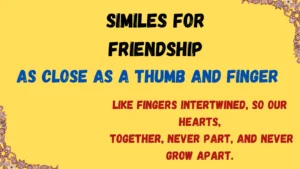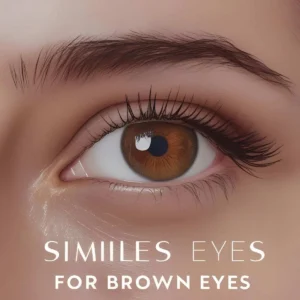Why Similes Are Super for Kids! 🎉
Similes are like magic wands, waving “like” or “as” to compare two different things and make words sparkle! They turn plain sentences into exciting adventures, helping kids describe their world with giggles and imagination. Instead of saying, “He runs fast,” try “He runs like a cheetah chasing lunch!” Similes for kids examples make stories, schoolwork, and chats more colorful and easy to understand. Whether kids are writing a story, sharing a joke, or talking at the dinner table, similes bring their ideas to life. Ready for some fun? Let’s explore 25 similes for kids, grouped by theme, to inspire laughter and creativity! 🚀
Similes for Kids Examples: 25 Playful Comparisons
These 25 similes capture the joy, energy, and wonder of being a kid—playing, learning, dreaming, and more. Organized into thematic groups, each simile includes a meaning, a kid-friendly example, and a specific way to use it in writing, speaking, or play. Let’s jump into the fun!
Kids at Play 🛝
Similes for kids zooming, jumping, or having fun.
- Kids zoom like racecars, speeding through the playground.
Meaning: Kids move super fast during play, like racecars on a track.
Example: In a school story, “She zoomed like a racecar, racing to the slide first!”
Application: Use in a playground tale or a recess caption, e.g., “Zooming like racecars at break! 🏎️” - Kids bounce like kangaroos, hopping with energy.
Meaning: Kids jump with endless excitement, like kangaroos bounding across fields.
Example: In a birthday party scene, “He bounced like a kangaroo, chasing balloons everywhere.”
Application: Perfect for a party invitation or a story about active kids. - Kids sparkle like fireflies, lighting up games.
Meaning: Kids glow with enthusiasm during play, like fireflies at night.
Example: In a backyard adventure, “They sparkled like fireflies, giggling in hide-and-seek.”
Application: Use in a summer camp journal or a social media post about playtime. - Kids swirl like pinwheels, spinning with joy.
Meaning: Kids move with dizzying delight, like pinwheels in the wind.
Example: In a park scene, “She swirled like a pinwheel, twirling on the grass.”
Application: Great for a dance recital note or a story about outdoor fun. - Kids scamper like squirrels, darting through fun.
Meaning: Kids run around playfully, like squirrels chasing nuts.
Example: In a playdate story, “They scampered like squirrels, climbing the jungle gym.”
Application: Use in a parent’s blog or a kid’s drawing caption about play.
Kids Learning and Growing 📚
Similes for kids in school or exploring new ideas.
- Kids soak up facts like sponges, gobbling up lessons.
Meaning: Kids absorb knowledge eagerly, like sponges soak water.
Example: In a classroom scene, “He soaked up facts like a sponge, learning about dinosaurs.”
Application: Use in a school report or a teacher’s note, e.g., “Soaking up math like a sponge! 🧽” - Kids shine like stars, glowing with new ideas.
Meaning: Kids light up with creativity, like stars in the night sky.
Example: In an art class story, “Her painting shined like a star, bursting with colors.”
Application: Perfect for an art project caption or a parent-teacher conference comment. - Kids grow like sunflowers, reaching for knowledge.
Meaning: Kids stretch toward learning, like sunflowers toward the sun.
Example: In a science fair tale, “He grew like a sunflower, asking big questions about plants.”
Application: Use in a science journal or a speech about young learners. - Kids are detectives, sniffing out answers like hounds.
Meaning: Kids hunt for solutions curiously, like detective dogs on a trail.
Example: In a library scene, “She was a detective, sniffing out answers in the book stacks.”
Application: Great for a reading log or a story about solving puzzles. - Kids bloom like crayons, coloring their brains with facts.
Meaning: Kids add vibrant knowledge to their minds, like crayons add color.
Example: In a spelling bee, “He bloomed like a crayon, spelling words with flair.”
Application: Use in a homework journal or a classroom poster about learning.
Kids with Big Feelings ❤️
Similes for kids expressing emotions or connecting with others.
- Kids giggle like bubbles, popping with happiness.
Meaning: Kids laugh with light, fizzy joy, like bubbles in soda.
Example: In a family story, “They giggled like bubbles, sharing jokes at dinner.”
Application: Use in a family newsletter or a story about happy moments. - Kids are hug magnets, pulling in love like metal.
Meaning: Kids attract affection naturally, like magnets draw metal.
Example: In a bedtime scene, “She was a hug magnet, snuggled by her teddy bear.”
Application: Perfect for a parent’s card or a story about cozy moments. - Kids shine like lighthouses, beaming with kindness.
Meaning: Kids share warmth and care, like lighthouses guide ships.
Example: In a friendship tale, “He shined like a lighthouse, helping his friend feel better.”
Application: Use in a kindness campaign or a note about friendship. - Kids flutter like butterflies, spreading joy with every smile.
Meaning: Kids share happiness lightly, like butterflies flit through gardens.
Example: In a class party, “She fluttered like a butterfly, making everyone laugh.”
Application: Great for a class scrapbook or a post about school spirit. - Kids are rainbows, painting feelings across their faces.
Meaning: Kids show emotions vividly, like rainbows show colors.
Example: In a play scene, “His face was a rainbow, glowing with excitement on stage.”
Application: Use in a drama club note or a story about expressing feelings.
Kids in Everyday Adventures 🏠
Similes for kids in daily routines or small moments.
- Kids chatter like chipmunks, talking non-stop at lunch.
Meaning: Kids talk excitedly, like chipmunks chattering in trees.
Example: In a cafeteria scene, “They chattered like chipmunks, swapping lunchbox treats.”
Application: Use in a school story or a lunch table caption. - Kids wiggle like jellybeans, squirming in their seats.
Meaning: Kids move restlessly, like jellybeans shaking in a jar.
Example: In a classroom tale, “He wiggled like a jellybean, eager for recess.”
Application: Perfect for a teacher’s anecdote or a post about class energy. - Kids are kites, soaring with after-school energy.
Meaning: Kids burst with freedom after school, like kites in the wind.
Example: In a park scene, “She was a kite, soaring with joy after the bell rang.”
Application: Use in a parent’s blog or a caption about after-school fun. - Kids dash like comets, zooming through chores.
Meaning: Kids tackle tasks quickly, like comets streaking across the sky.
Example: In a home story, “He dashed like a comet, tidying his room in record time.”
Application: Great for a chore chart note or a story about helping out. - Kids are popcorn, popping with ideas at storytime.
Meaning: Kids burst with thoughts, like popcorn in a hot pan.
Example: In a library scene, “They were popcorn, popping with questions during the read-aloud.”
Application: Use in a bedtime story journal or a post about book club.
Kids with Cultural Spark 🌍
Similes inspired by cultural or imaginative kid vibes.
- Kids are storyweavers, spinning tales like ancient bards.
Meaning: Kids create stories with magic, like bards sharing legends.
Example: In a storytelling club, “She was a storyweaver, spinning a tale about dragons.”
Application: Use in a creative writing piece or a speech about imagination. - Kids dance like drummers, moving to their own beat.
Meaning: Kids express themselves uniquely, like drummers with rhythm.
Example: In a cultural festival, “He danced like a drummer, grooving to the music.”
Application: Perfect for a dance recital note or a post about cultural events. - Kids are mosaics, piecing together colorful dreams.
Meaning: Kids blend ideas creatively, like mosaics form art.
Example: In an art show, “Her project was a mosaic, piecing together her wildest dreams.”
Application: Use in an art class reflection or a caption for a kid’s artwork. - Kids glow like lanterns, shining with wonder.
Meaning: Kids radiate curiosity, like lanterns at a festival.
Example: In a museum trip, “They glowed like lanterns, amazed by the dinosaur bones.”
Application: Great for a field trip journal or a post about discovery. - Kids are wizards, conjuring ideas from thin air.
Meaning: Kids create magic with their imagination, like wizards casting spells.
Example: In a playroom scene, “He was a wizard, conjuring a spaceship from blocks.”
Application: Use in a creative story or a note about imaginative play.
Creative Examples to Spark Giggles 😄
These similes make kids’ lives a blast! “Kids zoom like racecars” captures the thrill of playground races, perfect for a recess tale. “Kids are hug magnets” paints a cozy picture for a bedtime story. Ever think of yourself as a “wizard” building a fort? Try it in a playdate caption! Which simile feels like your kiddo—do they bounce like kangaroos or chatter like chipmunks?
Try This: Pick a simile and write a silly sentence about your day, like “I wiggled like a jellybean in class! 🍬” Share it with a parent or friend!
Practical Applications for Kids and Grown-Ups 🖌️
These similes can make kids’ words shine:
- Stories: Use “kids are popcorn” in a tale about a lively storytime, e.g., “They popped like popcorn with ideas.”
- Schoolwork: Add “kids shine like stars” to an art project note, showing creativity.
- Family Chats: Say “You’re a hug magnet!” at bedtime to make kids smile.
- Social Media: Post “Dashing like comets through chores! 🌠” for a fun family update.
- Class Fun: Toss “We’re wizards!” into a group project cheer for laughs.
Challenge: Rewrite a boring sentence, like “I played a lot,” to “I zoomed like a racecar!” See how it makes your story pop!
Conclusion: Let Similes Make Kids’ Words Soar! 🦋
Similes are like fairy dust, turning kids’ words into magical adventures. From “racecars” speeding through play to “wizards” dreaming big, these comparisons make stories, schoolwork, and chats super fun. Try one out—maybe “I’m a rainbow, smiling all day!” in your next drawing caption. Or invent your own: are you a “rocket” blasting through games? Share it with a friend or parent and watch the giggles grow. Kids, your words are a playground—jump in and play! 🌟



